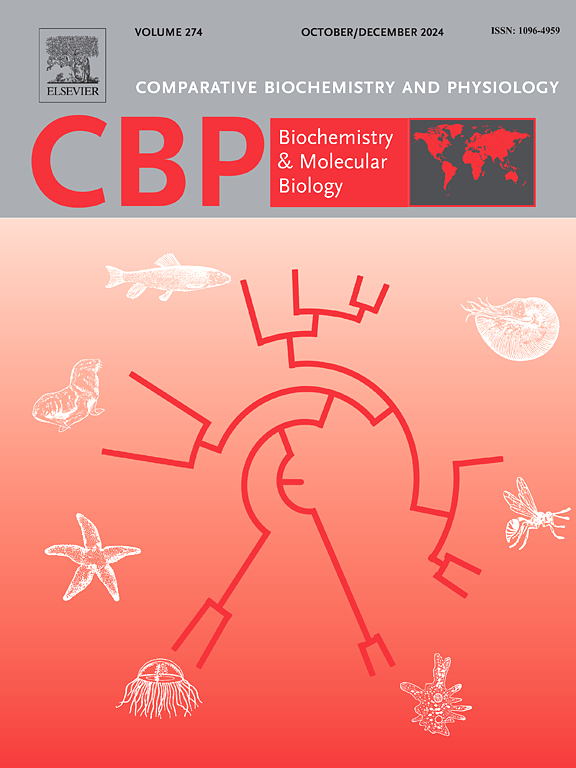Dietary thiamine supplementation enhances the growth performance, digestive enzyme activity, intestine development, immunity and anti-inflammatory gene expression of juvenile olive flounder (Paralichthys olivaceus)
IF 1.8
3区 生物学
Q4 BIOCHEMISTRY & MOLECULAR BIOLOGY
Comparative Biochemistry and Physiology B-Biochemistry & Molecular Biology
Pub Date : 2025-09-10
DOI:10.1016/j.cbpb.2025.111162
引用次数: 0
Abstract
This research aimed to determine the dietary requirement of thiamine and evaluate its effects on olive flounder (Paralichthys olivaceus). Control diet (Con) was formulated without thiamine supplementation, while four additional diets were formulated with thiamine concentrations of 4, 8, 12 and 16 mg/kg diet (designated as T4, T8, T12 and T16, respectively). A total of 300 fish (initial weight, 55.5 ± 1.3 g) were randomly distributed into 15 tanks (triplicate groups per treatment, 20 fish per tank) and fed for 10 weeks. One-way ANOVA was performed to analyze treatment effects. Final body weight was significantly increased in all the thiamine-supplemented groups compared to the Con group. Significant improvements in weight gain, specific growth rate and feed utilization were observed in T4 and T16 groups compared to the Con group. Immune responses, including anti-protease, lysozyme and myeloperoxidase activities and total immnunoglobulin concentration were significantly increased in the T4-T12 thiamine-supplemented groups. Antioxidant activity was significantly increased in all thiamine-supplemented groups. Trypsin activity was significantly elevated in the 4–12 mg/kg groups, while amylase and lipase activities were enhanced in all thiamine-supplemented groups. Anti-inflammatory genes were significantly upregulated in thiamine-supplemented groups compared to the Con. Thiamine supplementation promoted an increase in goblet cell count and villi length in intestine. A broken-line regression analysis for weight gain indicated that the optimal thiamine requirement for olive flounder would be 3.05 mg/kg diet. These findings demonstrate the positive effects of dietary thiamine on growth, immunity, antioxidant activity, digestive enzyme activity and intestinal health in olive flounder.

饲粮中添加硫胺素可提高橄榄比目鱼幼鱼的生长性能、消化酶活性、肠道发育、免疫力和抗炎基因表达。
本研究旨在确定饲料中硫胺素的需要量,并评价硫胺素对橄榄比目鱼的影响。对照组饲喂不添加硫胺素的饲粮(Con),添加硫胺素浓度为4、8、12和16 mg/kg的饲粮(分别命名为T4、T8、T12和T16)。试验选取初始体重为55.5 ± 1.3 g的300尾鱼,随机分为15个试验池(每个处理3个重复组,每个试验池20尾鱼),饲喂10 周。采用单因素方差分析分析治疗效果。与对照组相比,所有补充硫胺素组的最终体重均显著增加。与Con组相比,T4组和T16组的增重、特定生长率和饲料利用率均有显著提高。T4-T12硫胺素补充组的免疫应答,包括抗蛋白酶、溶菌酶和髓过氧化物酶活性以及总免疫球蛋白浓度显著升高。各硫胺素添加组抗氧化活性均显著提高。4 ~ 12 mg/kg组胰蛋白酶活性显著升高,各硫胺素添加组淀粉酶和脂肪酶活性均显著升高。与对照组相比,补充硫胺素组抗炎基因显著上调。补充硫胺素促进了肠杯状细胞计数和绒毛长度的增加。对增重的折线回归分析表明,橄榄比目鱼的最佳硫胺素需取量为3.05 mg/kg日粮。由此可见,饲粮中添加硫胺素对橄榄比目鱼的生长、免疫、抗氧化活性、消化酶活性和肠道健康均有积极影响。
本文章由计算机程序翻译,如有差异,请以英文原文为准。
求助全文
约1分钟内获得全文
求助全文
来源期刊
CiteScore
4.60
自引率
4.50%
发文量
77
审稿时长
22 days
期刊介绍:
Comparative Biochemistry & Physiology (CBP) publishes papers in comparative, environmental and evolutionary physiology.
Part B: Biochemical and Molecular Biology (CBPB), focuses on biochemical physiology, primarily bioenergetics/energy metabolism, cell biology, cellular stress responses, enzymology, intermediary metabolism, macromolecular structure and function, gene regulation, evolutionary genetics. Most studies focus on biochemical or molecular analyses that have clear ramifications for physiological processes.

 求助内容:
求助内容: 应助结果提醒方式:
应助结果提醒方式:


